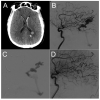Delayed Intracerebral Hematoma after Ventriculoperitoneal Shunt in the Context of Ruptured Brain Arteriovenous Malformation: A Literature Review
- PMID: 37626515
- PMCID: PMC10452536
- DOI: 10.3390/brainsci13081159
Delayed Intracerebral Hematoma after Ventriculoperitoneal Shunt in the Context of Ruptured Brain Arteriovenous Malformation: A Literature Review
Abstract
Hemorrhagic complications arising from ventricular drainage procedures are typically asymptomatic and of low volume. A particular subset of these complications, known as delayed intracranial hemorrhage (DICH), is however recognized for its particularly poor prognosis. We primarily aimed to identify epidemiological characteristics associated with DICH, to shed light on its occurrence and potential risk factors. To do so, we performed a retrospective analysis of a series of ten patients who presented with DICH in the context of a ruptured brain arteriovenous malformation (bAVM) and a systematic literature review of all DICH cases reported in the literature. Our ten patients showed delayed neurological deterioration after a ventriculoperitoneal shunt (VPS) procedure, with a computed tomography (CT) scan revealing a DICH surrounding the ventricular catheter, distinct and away from the nidus of their previously ruptured bAVM. Four patients (40%) rapidly declined and passed away, three (30%) required surgical management and the remaining three (30%) demonstrated gradual clinical improvement with conservative management. In the literature, most patients presenting with DICH had hydrocephalus associated with neurovascular disorders (47% of cases), such as bAVM rupture in our present series. These constatations point out the significance of the underlying pathologies potentially being predisposed to these unusual complications.
Keywords: arteriovenous malformation; brain hemorrhage; hydrocephalus; ventriculoperitoneal shunt.
Conflict of interest statement
The authors declare no conflict of interest.
Figures





References
-
- Sussman E.S., Kellner C.P., Nelson E., McDowell M.M., Bruce S.S., Bruce R.A., Zhuang Z., Connolly E.S. Hemorrhagic Complications of Ventriculostomy: Incidence and Predictors in Patients with Intracerebral Hemorrhage: Clinical Article. JNS. 2014;120:931–936. doi: 10.3171/2013.12.JNS131685. - DOI - PubMed
LinkOut - more resources
Full Text Sources

